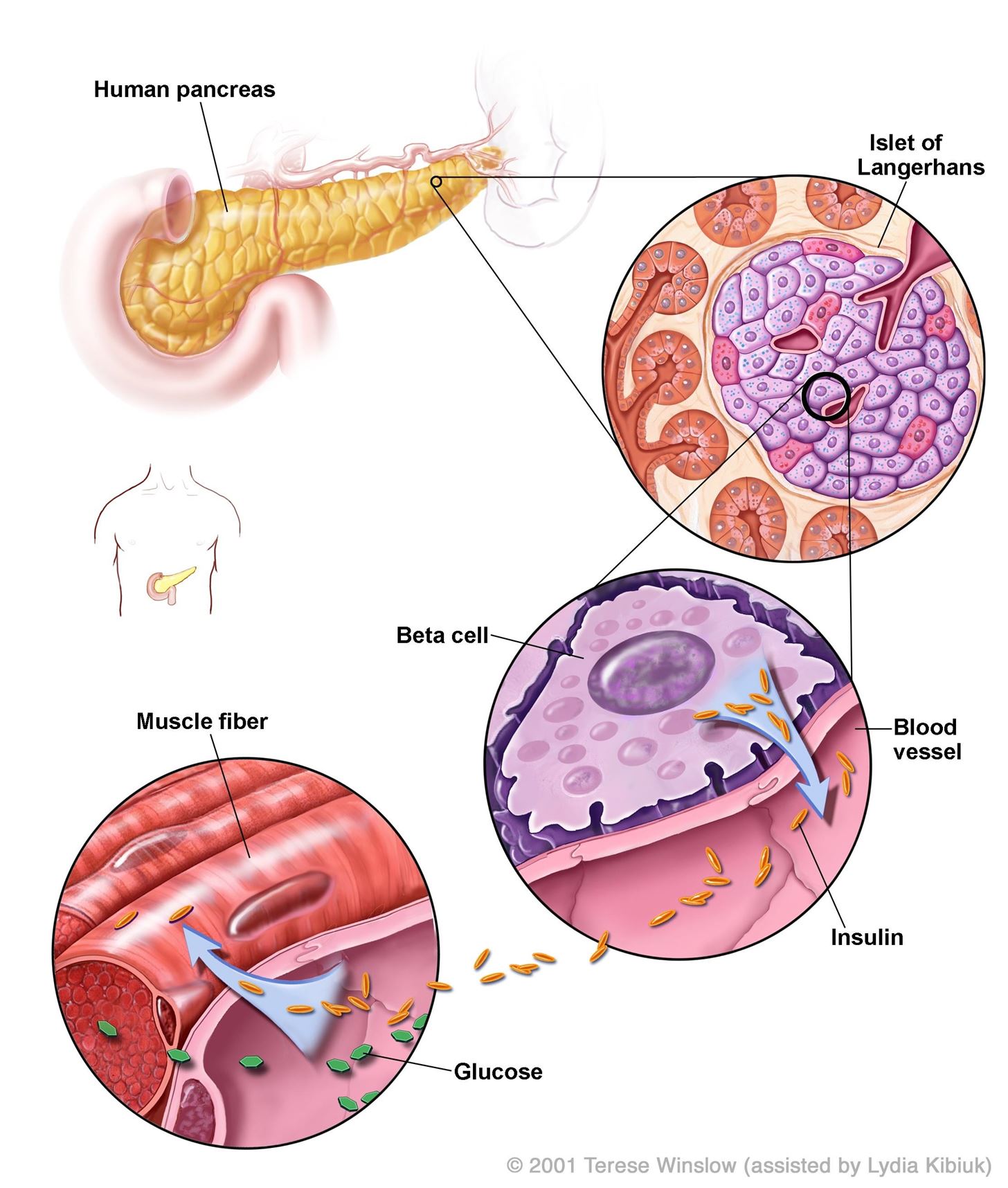A young child becomes very thirsty very often and seems tired all the time. A visit to the pediatrician determines she has type 1 diabetes. The onset of type 1 diabetes may seem sudden, and it can be, but the disease may actually have been triggered by common childhood viruses years earlier.
Type 1 diabetes—also called diabetes mellitus—was previously called juvenile-onset diabetes because most people affected with this disease are diagnosed as children and young adults. It isn't the most common form of diabetes and only 5% of people with diabetes have type 1. That doesn't make it any less serious—in fact, it can be a life-threatening disease.
When we eat something, our body converts carbohydrates and starches in the food into sugar (glucose), which is then processed by our bodies to either be used or stored for later.
People with type 1 diabetes have trouble keeping their blood sugar level even: It spikes when they eat something and goes very low if they don't. That's because their pancreas doesn't make insulin, the hormone that in a healthy human moves glucose from the blood into cells where it can be used for energy, keeping it from spiking after eating. Type 1 diabetics must constantly monitor their blood sugar and take insulin to keep their levels within a normal range to keep this process running.

Type 1 diabetes is an autoimmune disease, a disease where the body forms antibodies to itself and attacks parts of its own body. In this case, antibodies are formed to the insulin-producing beta cells in the pancreas and destroys them. Experts believe type 1 diabetes may be caused by a genetic risk factors and environmental factors, including viruses.
A viral link to type 1 diabetes is one of the findings in a new study led by Hanna Honkanen and Heikki Hyöty in the Department of Virology at the University of Tampere in Finland, to be published in an upcoming issue of Diabetologia.
Type 1 Diabetes Is Really More Complicated Than That
The symptoms of type 1 diabetes may come on fast and include:
• increased thirst and urination
• increased hunger
• fatigue
• blurred vision
• numbness or tingling in the feet or hands
• sores that do not heal
• unexplained weight loss
Managing type 1 diabetes is not as simple as keeping the blood glucose within a certain range, usually between 80–130 mg/dl when measured before a meal.

Even with careful attention to maintaining glucose levels, people with type 1 diabetes can develop eye disease, nerve damage, kidney disease, heart disease, and stroke. Studies have shown that the lifespan of people with type 1 diabetes is 11-13 years less than people without the disease.
Insulin injections are not the only answer to health problems caused by type 1 diabetes. Finding a cure might prevent the associated health problems, and the first step in finding a cure is finding a cause.
Where the Search for a Cause Has Led Us
Enterovirus infections have already been linked to type 1 diabetes, but the connection was not firmly established.
The enterovirus family includes coxsackievirus, enterovirus, poliovirus, and echovirus. Children infected with enteroviruses may have no signs and symptoms, or they may have fevers, sore throat, vomiting, diarrhea, abdominal pain, skin rash, eye inflammation (conjunctivitis), and sharp pains in the rib muscles.
Coxsackievirus A16 causes hand, foot, and mouth disease that is often accompanied by a fever and small blister-like rashes on the hand, soles of the feet, mouth, and diaper area.
Enterovirus infections are very common in children and usually cause a mild disease. Hand-washing helps, but there is no effective way to avoid them.

To clarify the link between virus and diabetes, researchers Honkanen and Hyöty studied 411 children, determining their infection with enterovirus by measuring viral RNA in their stool samples. Stool samples were analyzed starting at 3 months of age until the children were 2-3 years old.
Antibodies to pancreatic islet cells were measured in the blood periodically.
When the data for viral infections was correlated with islet antibodies, the researchers found that enterovirus infections were detected more often in children who formed islet antibodies—in other words, those children who went on to develop type 1 diabetes.
75% of the children who were antibody positive had already developed type 1 diabetes. Other studies than this have showed that being positive for multiple autoantibodies predicts the development of T1D [type 1 diabetes] very well so eventually all of the autoantibody positive children in this study should develop type 1 diabetes.
When the data was adjusted for a 10 year follow-up period, children with type 1 diabetes were found to have three times more enterovirus infections than control children, at 6.3 compared to 2.1 infections over the 10 year follow-up period. Children can develop multiple enterovirus infections, even within one year, according to Honkanen.
Children who went on to develop islet antibodies did so about a year after infection with enterovirus. The average age at children developed islet antibodies was 23 months and diabetes was diagnosed at an average of just less than 6 years of age.
The research team suggested that the lag between infection and development of islet antibodies was significant and might represent a time when islet cells were being damaged by the antibodies—damage that led eventually to type 1 diabetes.
More investigations into these theories need to be carried out before it can be said that infection with enterovirus caused islet antibodies or type 1 diabetes. But, if enterovirus infections do turn out to be a key driver of type 1 diabetes, then one of researchers' next moves may be to work on developing a vaccine to prevent these viruses.
Since polio is a member of the same viral family, perhaps the progress we've already made eliminating that disease can extend to other enteroviruses—and maybe prevent some cases of type 1 diabetes.
Just updated your iPhone? You'll find new emoji, enhanced security, podcast transcripts, Apple Cash virtual numbers, and other useful features. There are even new additions hidden within Safari. Find out what's new and changed on your iPhone with the iOS 17.4 update.



























Be the First to Comment
Share Your Thoughts